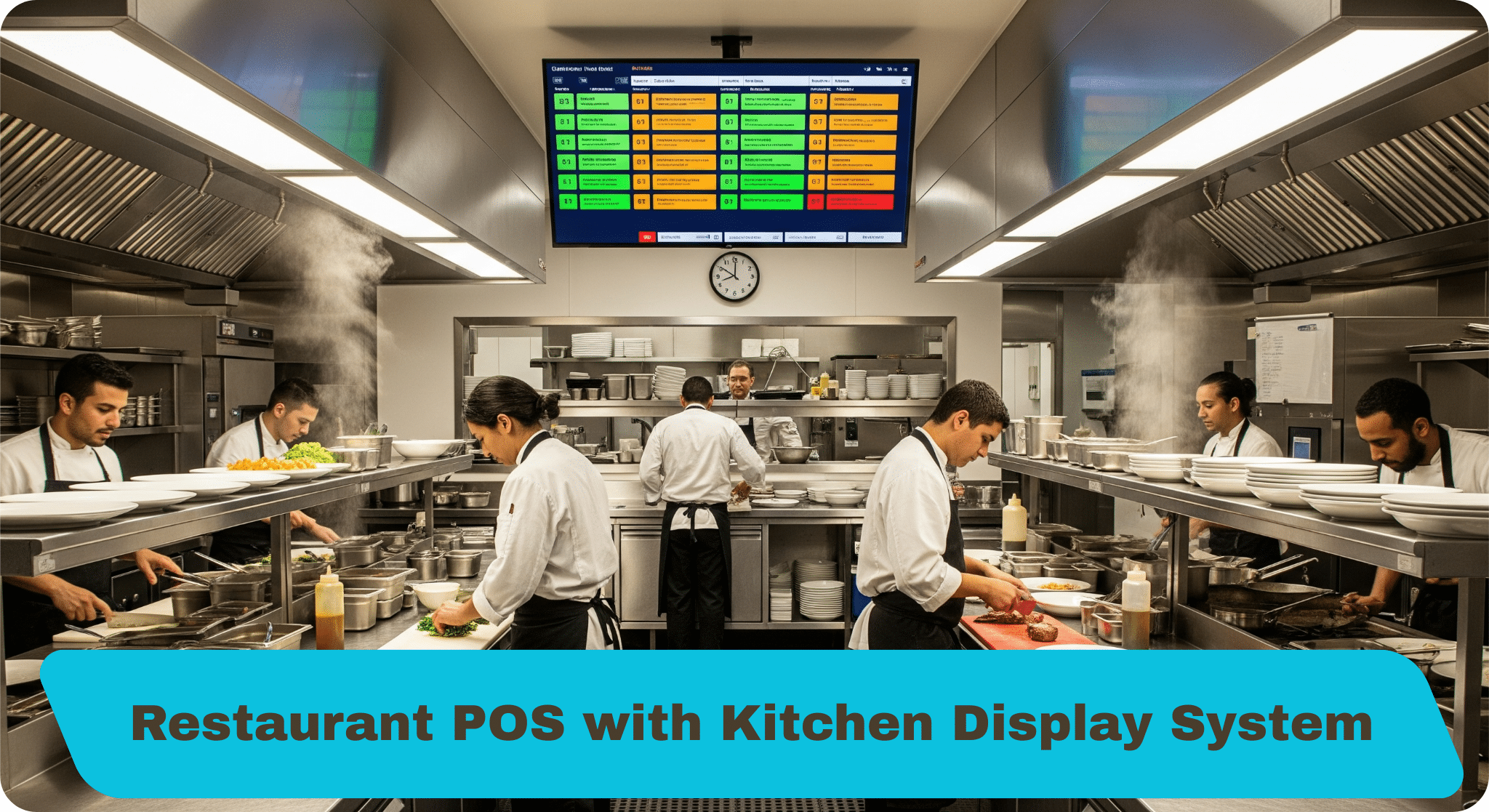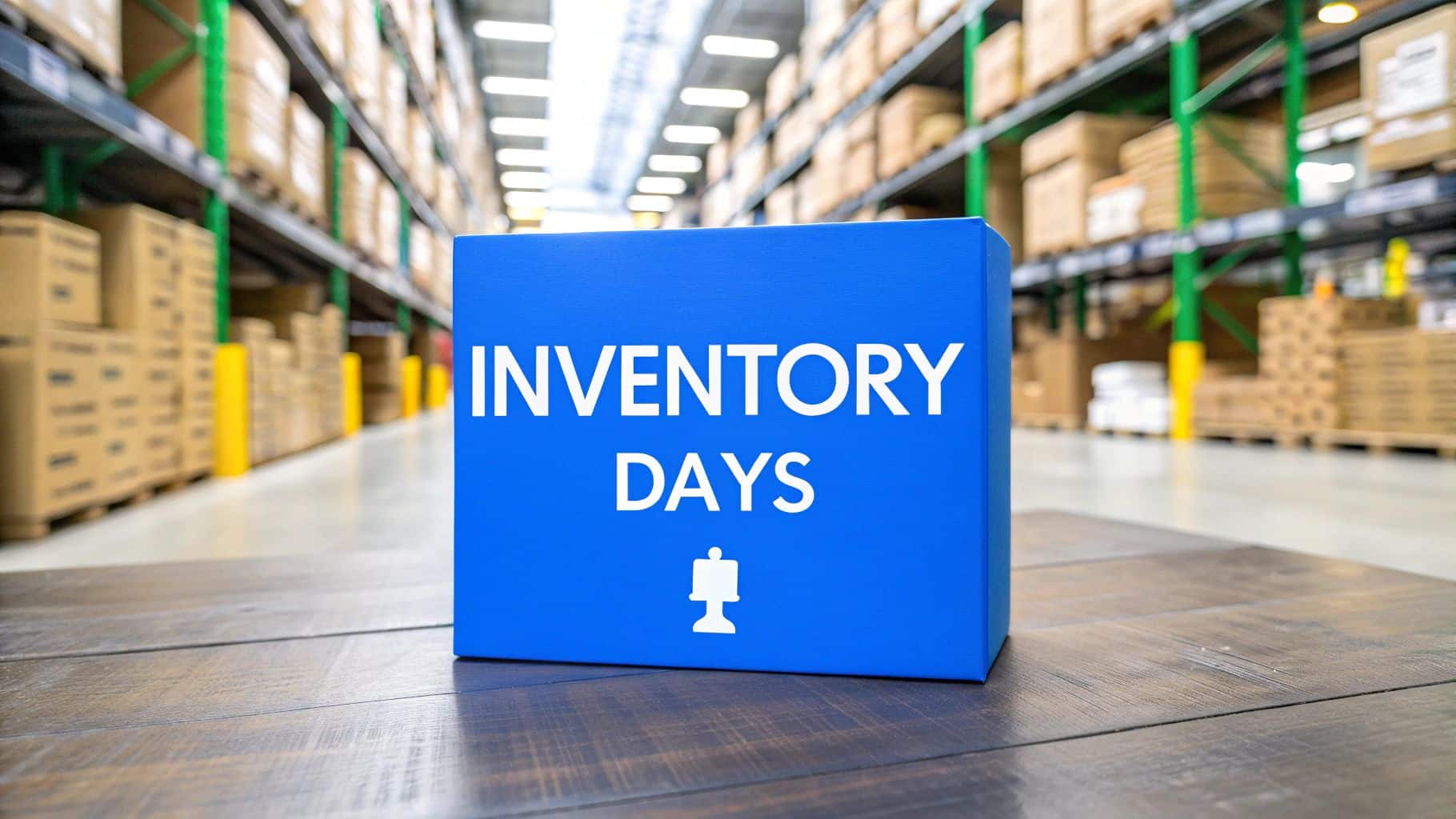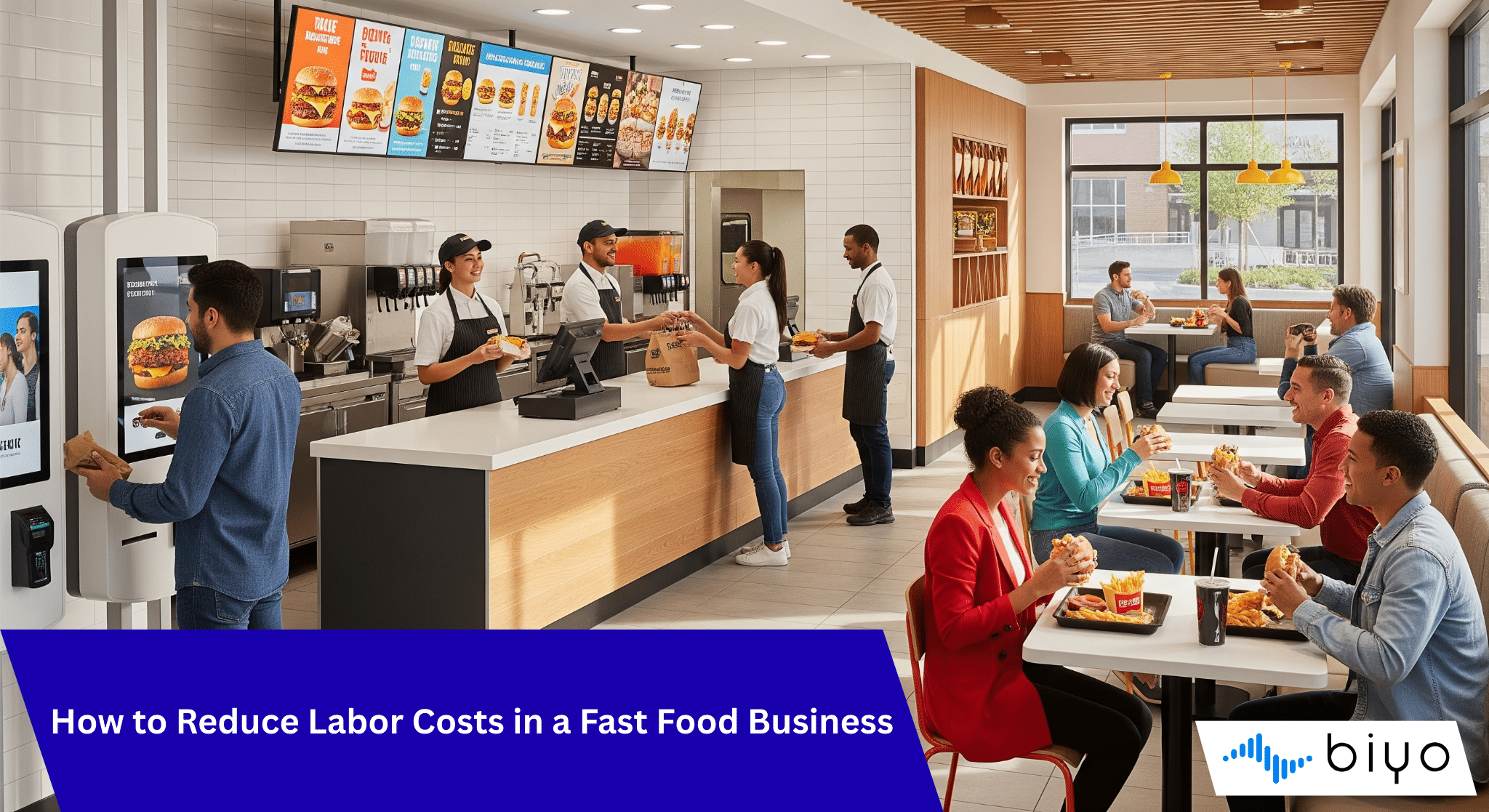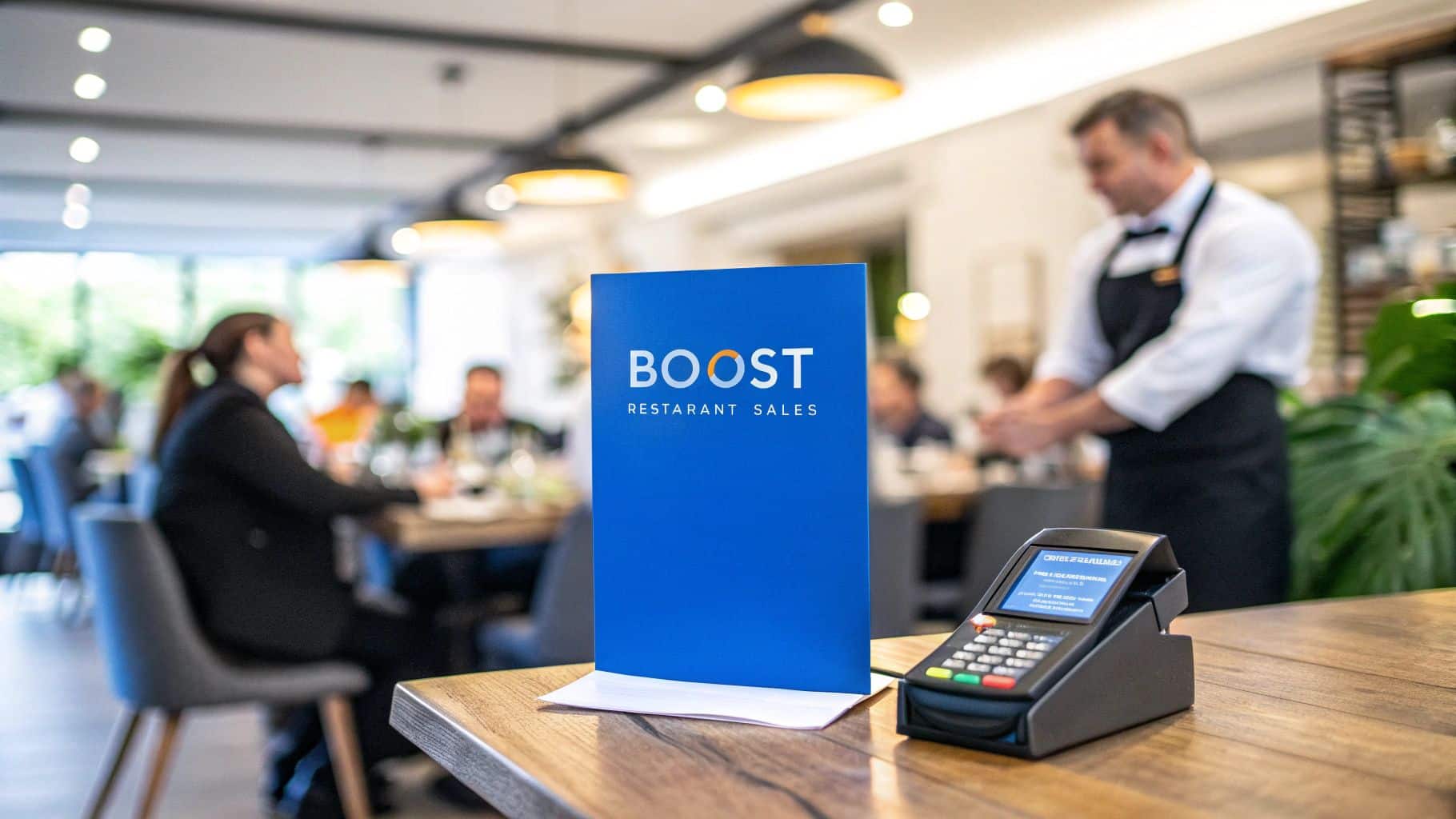If you’re wondering how to increase restaurant sales, the answer isn’t just about what happens inside your four walls. It’s about blending smart strategy with modern technology. The most direct path to growth today is building a strong digital presence. This means turning your website from a simple online menu into a powerful sales engine with seamless online ordering, contactless payments, and easy-to-use reservation systems.
Build Your Digital Storefront to Attract More Diners
Think of your restaurant’s online presence as its second location—one that’s open 24/7. A basic website with your address and hours just doesn’t cut it anymore. Today’s customers expect a frictionless digital experience where they can browse your menu, place an order, and pay, all in a few clicks. This digital storefront is your hardest-working salesperson, constantly attracting new diners and making it incredibly easy for regulars to come back for more.
Your physical restaurant can only serve the people who walk through the door. Your digital storefront, on the other hand, can reach your entire neighborhood, the city, and even visitors planning a trip. It’s absolutely essential for unlocking new revenue and meeting the expectations of the modern diner.
Integrating the Right Technology Stack
Building a solid digital presence starts with picking the right tools. The goal here isn’t just to add tech for the sake of it; it’s about creating an interconnected system that makes your operation smoother and directly drives sales. And the great thing is, these tools can level the playing field, working just as well for a small neighborhood bistro as for a major restaurant chain.
Here are the non-negotiables for a modern restaurant’s tech stack:
- Online Ordering Systems: This is a must-have, whether you integrate it directly into your website or use a third-party app. You need to capture sales from customers who want to enjoy your food at home.
- Contactless Payments: Giving guests options like Apple Pay, Google Pay, or simple QR code payments does more than just speed up the checkout process. It caters to their demand for security and convenience.
- Reservation Apps: A good reservation system does more than just book tables. It can reduce no-shows with automated reminders and lets guests secure a spot whenever it’s convenient for them, day or night.
These tools aren’t just add-ons; they’re a direct response to huge shifts in how people dine. The global foodservice market is projected to hit over $4.1 trillion by 2033, and restaurants that get their tech right are the ones seeing the most growth.
It’s not uncommon for off-premises dining to make up 60% of a restaurant’s sales. Operators with a smooth online platform often report net profit margins near 10%—that’s well above the industry average. For a deeper dive, you can explore more key restaurant industry statistics and see the trends for yourself.
To help you get started, here’s a look at some key technology investments and the kind of return you can expect.
Key Technology Investments and Their ROI
| Technology | Primary Function | Potential Impact on Sales |
|---|---|---|
| Integrated Online Ordering | Allows customers to order directly from your website or app for pickup or delivery. | Increases average order value and captures revenue from off-premises diners. |
| POS System with Analytics | Processes transactions and gathers data on sales, inventory, and customer behavior. | Identifies best-selling items and busy periods to optimize menus and staffing. |
| Reservation Management | Automates table bookings, manages waitlists, and sends reminders. | Reduces no-shows and maximizes table turnover, leading to more seated guests. |
| Contactless Payment Solutions | Enables secure, fast payments via mobile wallets or QR codes. | Speeds up table turns and enhances the customer experience, encouraging repeat visits. |
| Customer Loyalty Program | Rewards repeat customers with points, discounts, or exclusive offers. | Boosts customer retention and encourages more frequent visits and larger orders. |
Investing in even one or two of these areas can have a significant and immediate impact on your bottom line.
As the image below shows, a well-designed digital menu is at the heart of this entire strategy.
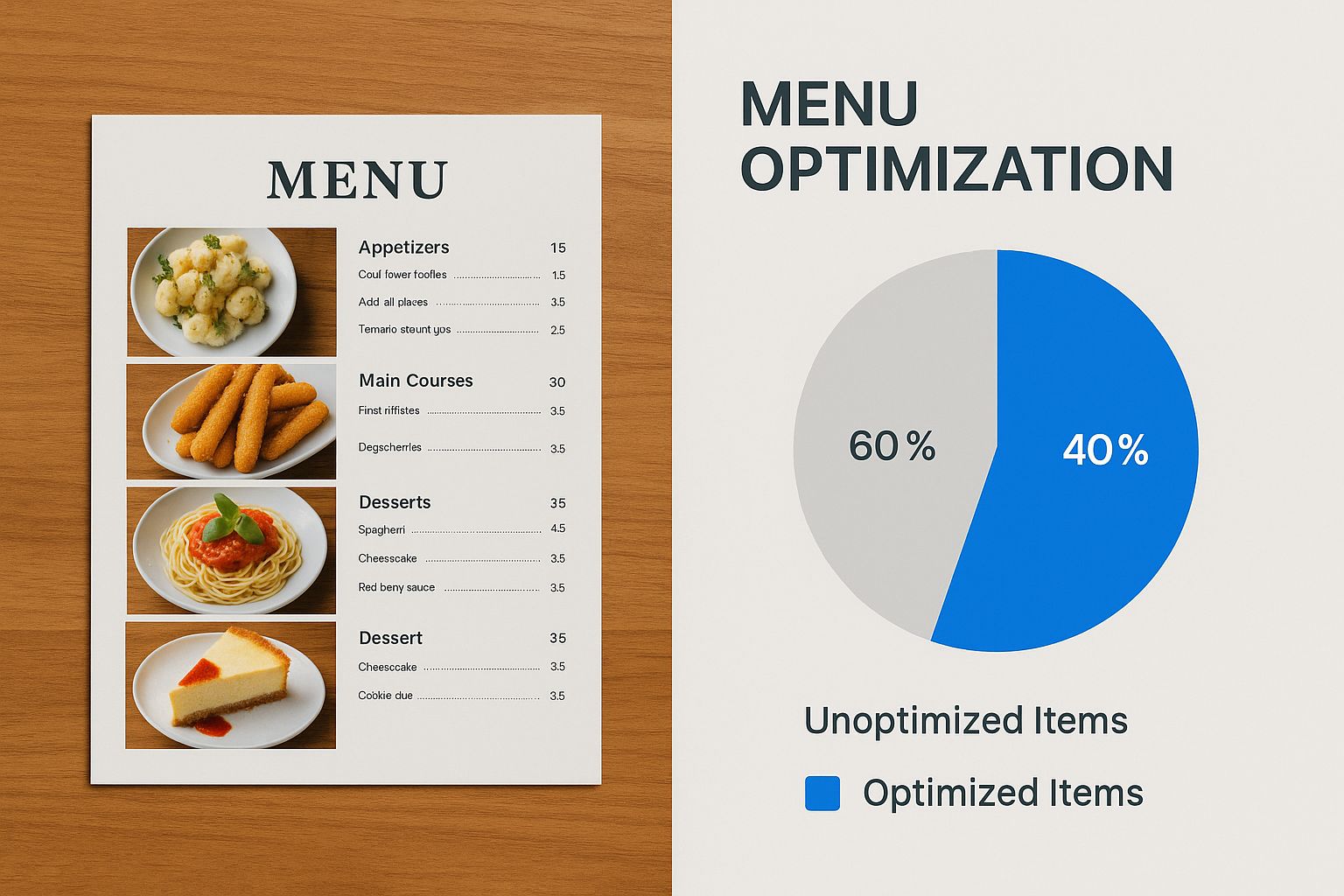
This visual really drives home the point: a clean digital menu with high-quality photos and enticing descriptions isn’t just for looks. It directly influences what customers decide to buy and is a proven way to increase the average value of each order.
Unlock Hidden Profits with Menu Engineering
Your menu isn’t just a list of what you sell. It’s your single most powerful sales tool. When you design it with a bit of strategy, it can gently nudge customers toward your most profitable dishes, bumping up your average check size without ever feeling like a hard sell. This whole concept is called menu engineering—it’s where sales data, psychology, and good old-fashioned strategy meet.
This isn’t about guesswork. It’s about digging into your own sales numbers to see what’s flying out of the kitchen, what’s actually making you money, and where the real opportunities are hiding. By looking at how every single item performs, you can make smart moves on pricing, layout, and descriptions that go straight to your bottom line.
Start by Classifying Your Menu Items
First things first, you need to sort every dish into one of four categories based on how popular it is (how many you sell) and how profitable it is (its contribution margin). This gives you a crystal-clear map of your menu’s strengths and weaknesses.
- Stars: These are your rockstars. Everyone loves them, and they make you great money. Think of that signature burger or craft cocktail people specifically come in for.
- Plowhorses: These are the crowd-pleasers that don’t make you much cash. They sell like crazy but have low profit margins. Your basic house fries or a simple side salad often fall into this category.
- Puzzles: These are the head-scratchers. They have fantastic profit margins, but for some reason, they just don’t sell well. It might be a unique seafood dish that just isn’t getting the attention it deserves.
- Dogs: These are the duds. They aren’t popular, and they aren’t profitable. They’re just taking up precious space on your menu and probably costing you more to prep than they’re worth.
Once you’ve sorted everything out, the real work begins. If you want a full playbook on how to do this from start to finish, our complete guide on using menu engineering to maximize profitability is the perfect next step. Understanding this is absolutely crucial if you want to increase restaurant sales.
Make Smart Moves for Each Category
Now that your menu is sorted, you can apply some tried-and-true tactics to each group to get the most out of every item.
With your Stars, the job is simple: keep them front and center. Feature them prominently on your menu, maybe in the top-right corner where the eye naturally lands first. Use mouth-watering descriptions. “Our slow-braised, fall-off-the-bone short rib” is always going to sell better than just “Short Rib.”
For the Plowhorses, the goal is to make them more profitable. Can you bump the price up just a little? Or maybe tweak the ingredients to lower your food cost without sacrificing quality? Another great move is to bundle them with a high-margin add-on, like turning a burger into a combo with a craft soda.
A common mistake is leaving Plowhorses alone just because they sell well. A tiny price increase of $0.50 on a popular but low-margin item that sells 100 times a week adds up to over $2,600 in pure profit over a year. Small changes make a big difference.
Puzzles just need a little marketing push. Try moving them to a more visible spot on the menu, have your servers recommend them, or feature one as a special for a week to see if you can build some buzz. Sometimes, all it takes is a more creative name or a better description to transform a Puzzle into a Star.
And finally, your Dogs. The best move here is usually the simplest: get rid of them. They’re dead weight, costing you money and making your menu feel cluttered. Cutting them simplifies things for your kitchen and your customers, and it opens up a spot for your next potential Star.
Turn First-Time Guests into Loyal Regulars
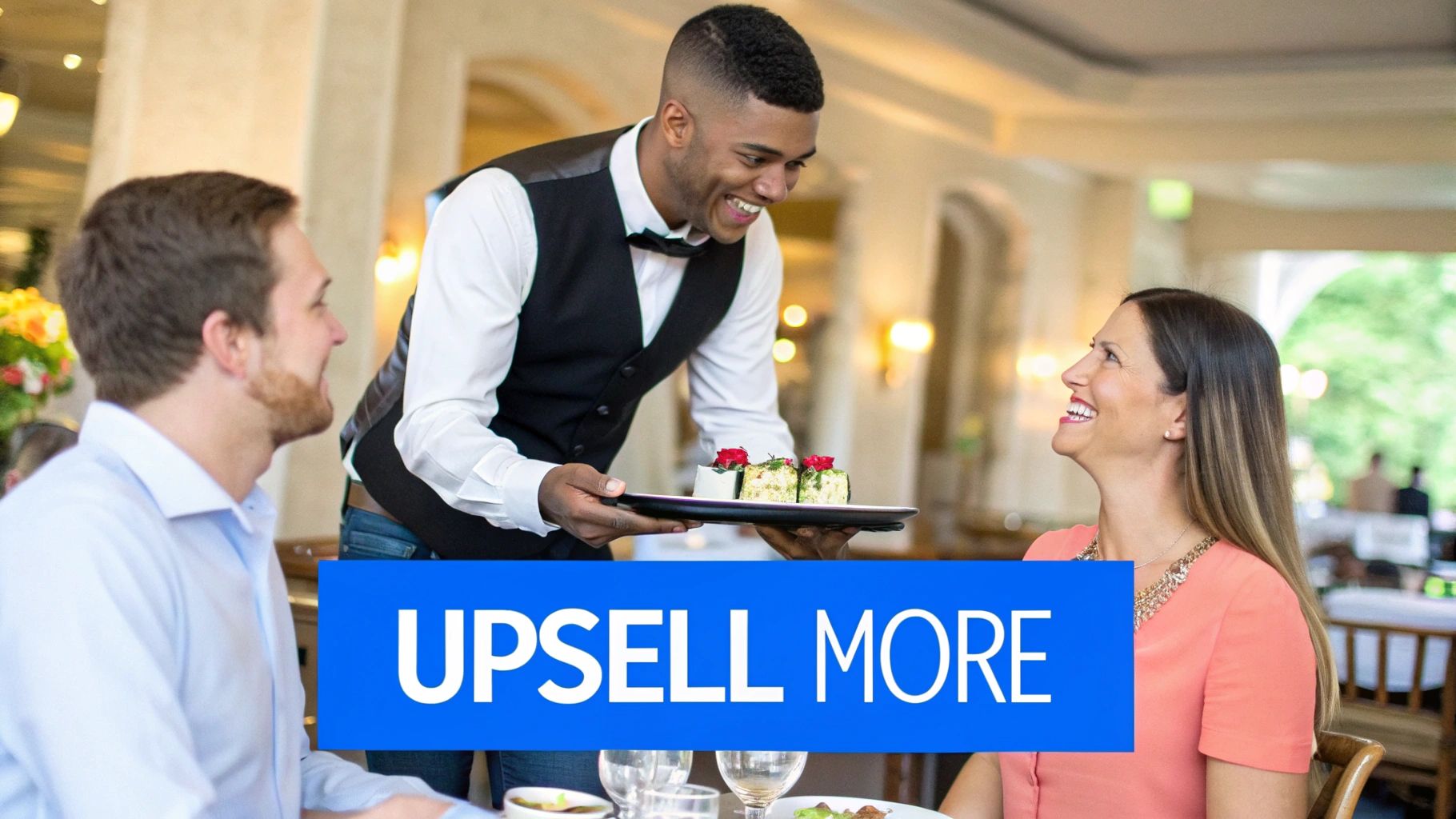
Getting a new customer through the door is a win, no doubt. But the real secret to a healthy bottom line is getting them to come back again and again.
Think about it: it can cost a staggering five times more to attract a new face than to keep an existing customer happy. When you turn a first-time visitor into a regular, you’re not just making a sale; you’re building a reliable, predictable source of revenue for your business.
This isn’t just about transactions. It’s about relationships. A loyal guest not only spends more over their lifetime but also becomes your best marketing tool, telling friends and family all about their favorite spot.
Craft a Loyalty Program People Actually Use
Let’s be honest, the old “buy ten, get one free” punch card isn’t cutting it anymore. In today’s market, the best loyalty programs are smart, personal, and offer rewards that feel truly special. The goal is to make your regulars feel like valued insiders.
Instead of just offering another discount, try giving them an experience. These are the kinds of rewards that create a real emotional connection and get people talking.
Here are a few ideas to get you started:
- Exclusive Access: Give your regulars first dibs on reservations for a holiday tasting menu or a special event with a guest chef.
- Tiered Rewards: Set up different levels (think Bronze, Silver, Gold) where the more a guest spends, the better the perks. Maybe your “Gold” members get a complimentary glass of wine with every visit.
- Surprise and Delight: Use your customer data to send unexpected treats, like a free dessert on their birthday or even their half-birthday. It’s a small touch that makes a huge impact.
By mixing predictable rewards with unexpected surprises, you keep the program fresh and give customers a compelling reason to choose you over the competition down the street.
Personalize the Guest Experience with a CRM
The key to making someone feel special is remembering the little things. This is where a Customer Relationship Management (CRM) system, often built right into modern POS platforms, is a game-changer. A good CRM lets you track guest preferences and visit history, transforming standard service into a truly personal experience.
Just imagine a server greeting a familiar couple with, “The usual Sauvignon Blanc to start?” Or seating them at their favorite corner table without being asked. These small gestures show you see them as people, not just another ticket number.
Targeting customer experience customization is a key driver for restaurant sales. Recent data shows that restaurants with well-developed loyalty programs can boost customer retention by up to 30%, leading to a 25-50% greater lifetime value per customer. These efforts are part of a larger trend that saw an 82% surge in sales from 2020 levels as restaurants focused on personalization.
In the end, building loyalty is all about fostering a genuine connection. To dig deeper into this, check out these proven customer retention strategies for more ideas on turning new faces into regulars.
Win Your Neighborhood with Smart Local Marketing
Having amazing food and stellar service is the foundation of any great restaurant, but let’s be honest—that’s just not enough anymore. To really become the go-to spot in your area, you have to actively win over your neighborhood. This is how you shift from being just another option to being the only option people think of when they’re hungry.
Winning your neighborhood means being visible right where your potential customers are looking. And these days, that search almost always starts online. We’ve seen that nearly half of all diners use social media to find new spots, and an even bigger chunk turns to Google the moment hunger hits.
Dominate Local Search Results
Think about it: when someone nearby pulls out their phone and searches for “best tacos near me,” your restaurant has to show up. This is the new foot traffic, and it’s driven entirely by local SEO.
Getting your online presence dialed in is one of the most direct ways to put more people in your seats. The absolute best place to start is your Google Business Profile—it’s free and incredibly powerful. Fill it out completely with high-quality photos, your full menu, and dead-accurate hours. To really get those tables turning, you need a solid game plan; using specific strategies like local SEO for restaurants can directly convert those online searches into paying customers.
Here are a few things you can do right now to improve your local search ranking:
- Keep It Consistent: Your restaurant’s name, address, and phone number need to be exactly the same everywhere online, from your website to Yelp to TripAdvisor. No exceptions.
- Ask for Reviews: Don’t be shy. When a customer has a great experience, ask them to leave a review on Google. Those positive ratings are gold for your local ranking.
- Speak the Local Language: Naturally sprinkle your city or neighborhood’s name into your website copy and menu descriptions. Think “Uptown’s favorite brunch” instead of just “brunch.”
Turn Social Media into a Sales Channel
Your social media isn’t just a gallery for food photos. It’s your digital storefront, a place to tell your story, and a hub for your community. It’s where you can connect with regulars and welcome new guests before they ever walk through the door.
I’ve seen it firsthand: an incredible 27% of restaurant bookings are now driven directly by influencer content. Teaming up with local food bloggers or micro-influencers who already love what you do can get your restaurant in front of thousands of potential new fans overnight.
The real key is creating content that makes people feel something. Show them what happens behind the scenes in the kitchen, put a spotlight on your amazing team members, or run a poll asking followers what cocktail special they want to see this weekend. For a deeper dive, check out these effective restaurant marketing strategies to really build that connection.
Build Real-World Community Connections
As vital as digital marketing is, never underestimate the power of good old-fashioned, face-to-face relationships. Getting involved in your local community builds incredible goodwill and keeps your restaurant on everyone’s radar.
Sponsor the local little league team. Set up a tasting booth at a neighborhood festival. Host a charity night and donate a percentage of sales to a local cause. These actions show you care about more than just profits.
You can also team up with other local businesses. A nearby clothing boutique could hand out coupons for a free appetizer at your place, and you could do the same for them. These kinds of partnerships build a powerful referral network that brings new business to everyone involved.
Turn Your Team into Sales Superstars
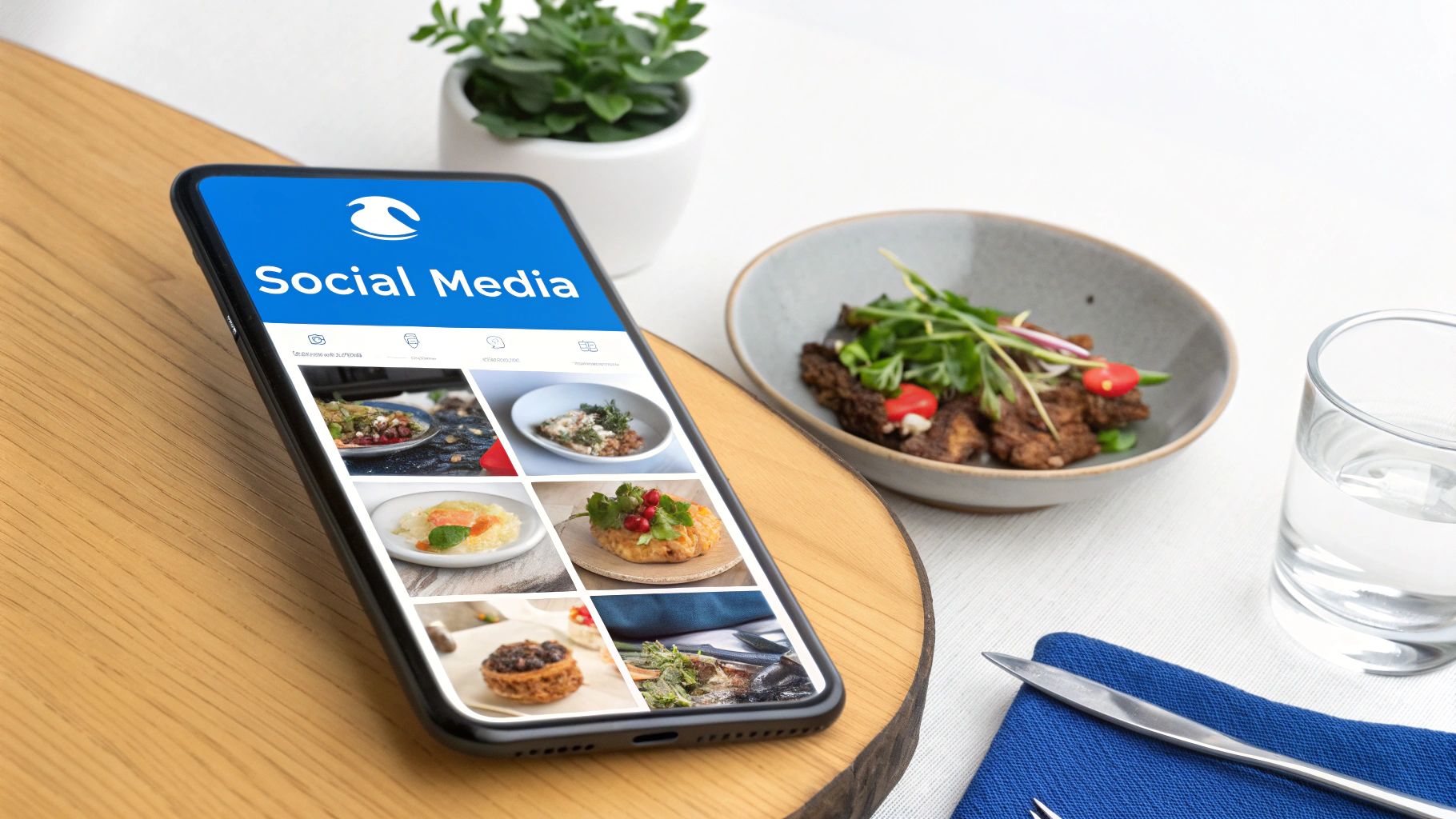
Think about it: your front-of-house team has a conversation with every single guest who walks through your door. They’re not just taking orders; they’re your brand ambassadors and, frankly, your most powerful sales asset. When you give them the right tools and a little motivation, you’ll see a direct impact on your sales and the overall guest experience.
This isn’t about being pushy. Nobody likes an aggressive upsell. The real art lies in suggestive selling, where genuine, helpful recommendations make the dining experience even better. When a server can confidently suggest the perfect wine to go with the steak or describe a special with real passion, they build trust. That trust naturally leads to a higher check average.
Train for Confident Recommendations
Great training is where it all begins. Your staff needs to know the menu backward and forward—not just the ingredients, but the stories behind the dishes. They should know which items are your high-margin “Stars” and be able to explain why they’re so fantastic.
Role-playing is one of the best ways to build this confidence. Get your team practicing real-world scenarios so they can perfect their pitch.
- Be Specific: Ditch the generic, “Can I get you anything else?” Instead, try something like, “Our crispy Brussels sprouts with balsamic glaze are the perfect thing to snack on while you look over the mains.” It’s a direct, appealing suggestion.
- Paint a Picture: Train them to use mouth-watering language. “The short rib is good” sells nothing. But, “Our chef slow-braises the short rib for 6 hours until it just falls off the bone” gets people excited.
- Offer Premium Upgrades: These are simple but effective wins. Think suggesting a top-shelf gin for a G&T or adding perfectly grilled shrimp to a salad for a few extra dollars.
A well-trained server isn’t just selling food; they’re curating an experience. When they can guide a guest to a dish they absolutely love, it leads to bigger tips, fantastic reviews, and a happy customer who will definitely be back. It’s a win for everyone.
Fire Up Your Team with Incentives
A little friendly competition never hurt anyone. Simple, clear incentive programs can work wonders for motivating your staff and making sales goals feel like a team sport. These programs are a smart way to approach cost management and increasing restaurant profitability.
You could run a weekly contest to see who sells the most of a particular high-profit dessert or appetizer. The prize doesn’t need to be huge—a small cash bonus, a gift card, or even just some well-earned bragging rights can be surprisingly effective.
Track everything through your POS system to keep it fair and transparent. This gives you an easy way to reward your top performers and encourages the entire team to get involved in growing the business.
Optimize Your Off-Premises Dining Strategy
Takeout and delivery aren’t just an afterthought anymore; they’ve become a central part of how modern restaurants operate. For many of us in the industry, what happens outside our four walls is just as critical as the dine-in experience. If you’re serious about increasing restaurant sales, a solid off-premises game plan is non-negotiable.
This goes way beyond simply packing food into a container. It’s about building a seamless system—from the ordering tech you choose to the packaging that ensures your food arrives looking and tasting exactly as it should.
Master Your Delivery and Takeout Channels
Right off the bat, you have a big decision to make: are you going all-in with third-party apps, building your own delivery system, or trying to find a balance between the two? Each route has its own set of headaches and rewards.
- Third-Party Apps (Uber Eats, DoorDash): These services get your menu in front of a huge audience you might never reach otherwise. The trade-off? Those commission fees are steep and can seriously bite into your profit margins.
- In-House Delivery: When you run your own show, you control the entire customer journey and keep every dollar from the sale. But be prepared for the heavy lifting—you’re on the hook for the tech, the marketing, and managing a fleet of drivers.
I’ve found that a hybrid model often hits the sweet spot. You can use the big apps to attract new customers, but then you get clever. Tuck a small flyer into every delivery bag with a promo code for 10% off their next order if they place it directly through your website. It’s a simple way to convert an expensive third-party customer into your own.
A crucial part of making off-premises channels profitable is ensuring operational efficiency, no matter the scale. For restaurants expanding into mobile ventures, mastering this is key, starting with insights on designing a profitable food truck kitchen layout.
Design a Delivery-Friendly Menu and Packaging
Let’s be honest: not everything on your dine-in menu is built for travel. That perfectly crispy french fry becomes a sad, limp potato stick after 15 minutes in a steamy container. A soggy sandwich can ruin a customer’s perception of your brand in an instant.
It’s smart to create a dedicated menu for takeout and delivery. Focus on the dishes that you know will hold their temperature and texture well. Think hearty stews, rice bowls, and items that can be easily reheated without losing quality.
And don’t cheap out on packaging. It’s the first physical touchpoint a delivery customer has with your brand. Invest in quality, vented containers that prevent sogginess and keep the food looking great. Your packaging is a silent ambassador for your restaurant.
Look beyond standard delivery, too. Catering services for local offices and events can become a reliable, high-volume revenue source. You could also experiment with meal kits. Selling the components for your most popular dishes lets customers bring a piece of your restaurant into their own kitchens, which is a fantastic way to build a deeper connection with your regulars.
Got Questions? We’ve Got Answers
You’re not alone in trying to figure out how to boost your restaurant’s sales. It’s a question every owner wrestles with. Here are some straightforward answers to the questions I hear most often from operators in the trenches.
How Can I Get a Quick Sales Bump?
If you need to move the needle fast, focus on increasing your average check size. It’s often the lowest-hanging fruit. Get your servers comfortable and confident with suggestive selling—not just upselling.
It’s about genuinely recommending high-margin items that enhance the meal, like a specific appetizer that pairs perfectly with a popular entrée, a decadent dessert, or a premium cocktail. You’ll be surprised how quickly those small additions impact your daily revenue.
Another immediate tactic is the limited-time offer (LTO). Think about creating a “Chef’s Tasting Menu” for this weekend only and blasting it out on your social channels. That sense of urgency can pack your dining room.
What’s the Best Way to Boost Sales on Slow Weekdays?
Slow weekdays are the bane of every restaurateur’s existence. The key is to give people a specific reason to choose you over staying home. Don’t just offer a generic discount; create a targeted event.
- A “Lunch Power Hour” with guaranteed quick service can be a lifesaver for local office workers on a tight schedule.
- A “Wine Wednesday” with half-priced bottles can turn a slow night into a bustling one.
I’ve seen a simple “Kids Eat Free” night on a Tuesday completely change the dynamic for a family-style restaurant. It brings in families, sure, but it also builds that crucial reputation as a go-to community spot, which pays off all week long.
Are Those Delivery Apps Really Worth the Crazy Fees?
This is the big debate, isn’t it? The fees are steep, no doubt. But you have to stop thinking of them as just delivery services and start seeing them as marketing engines for customer acquisition.
Platforms like DoorDash or Uber Eats put your menu in front of thousands of potential new customers who’ve never heard of you. That’s powerful.
The smartest strategy is a hybrid one. Use the apps to get discovered. Then, work hard to convert those new customers into your customers. Include a flyer in every delivery bag with a special offer—like 10% off their first order—if they order directly from your website next time. You get the discovery without paying the commission forever.
Ready to streamline your operations and unlock new sales potential? See how the all-in-one Biyo POS system can transform your restaurant. Start your free trial today at https://biyopos.com.

